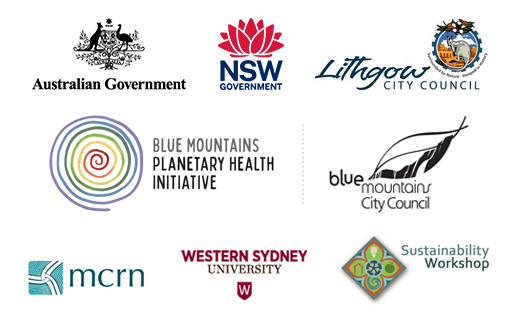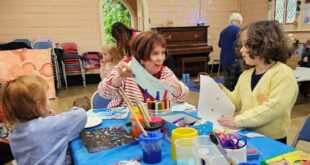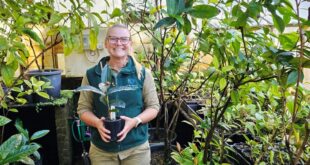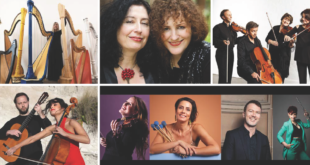
Volunteers taking part in the bird survey. Ecologist Paul Vale second from right. (Jess Lumbroso)
By Hamish Dunlop
Conservation Volunteers Australia recently facilitated a workshop in Blackheath where volunteers, citizen scientists and experts came together to share knowledge, survey bird populations and monitor nest boxes installed to support antechinus, glider and possum populations.
We’re standing on Dharug Country and land owned and cared for by the Johnstone family. David Jones is a Project Manager for Conservation Volunteers Australia (CVA). He’s telling the group about one of CVA’s central tenets: Heathy communities need healthy nature and heathy nature needs healthy communities. “What this project is hoping to do is improve resilience in our community and ecosystems by restoring bushland.”
David says that people have a desire to connect with the non-human world as much as with the human one. “People crave connection, but they are often unsure about how to get involved. Conservation Volunteers Australia runs environmental programs that have social outcomes. We’re very much about how we can help people make action for nature – that’s how the nest box project started.”

David inserting a cable camera into a nest box. (Hamish Dunlop)
The boxes are designed for small marsupials and mammals including the feathertail gliders, sugar gliders, pygmy possums and antechinus. The sugar gliders and pygmy possums are larger which is reflected in the size of the entry hole, around 5cm in diameter. The holes are made small enough to keep predators out.
Conservation ecologist Peter Ridgeway from Greater Sydney Local Land Services helped with the design of the boxes. They were made by a diverse range of volunteers at CVA’s office in Penrith; students, retirees, traveller and teams from local businesses.

Sugar glider (Dick Whitford, Australian Museum)
David says anyone looking to create habitat on their own properties can find design specifications on the Nest Box Tales website. “If you have a property, but don’t have hollow bearing trees, you can still contribute to promoting biodiversity. The boxes are also a fascinating learning and education tool. Today’s workshop is taking advantage of that to connect volunteers, landowners, local experts and Landcare staff and members.”
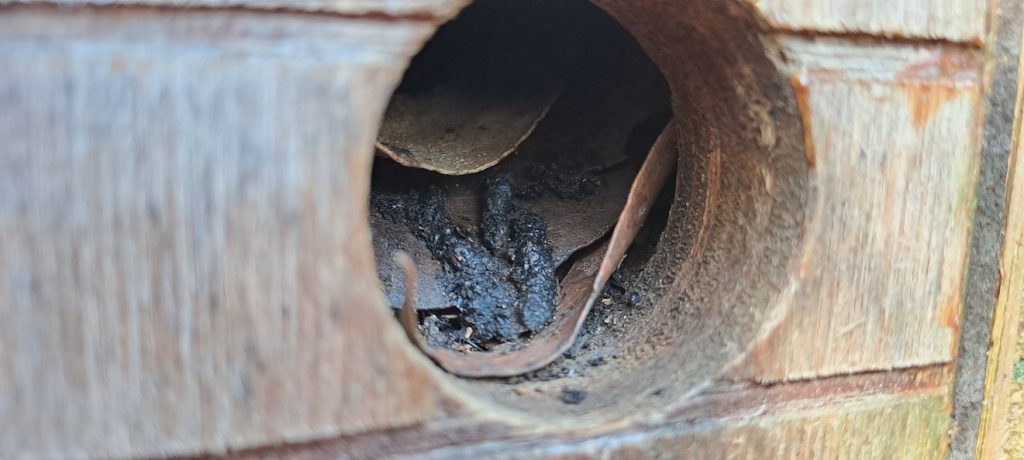
Animal scat at the entry of one of the nest boxes. (Hamish Dunlop)
One of the important parts of surveying is understanding what needs to be protected. David says that after the installation of the boxes in 2021, it’s about coming back and back to see what happens over time. On the day of the workshop, around 15 of the 33 nest boxes got checked. Two of them were either occupied or had been occupied. David gathered scat to send away for DNA testing. This can identify the exact species, but David thinks it’s a sugar glider.
He says that how you build nest boxes and where best to install them is not an exact science. Some nest boxes – not part of this project – are 3D printed and have longer life spans and better thermal properties. He’s quick to point out that nest boxes are simply no substitute for natural hollows. “Hollows generally form after decades, so protecting mature age trees is critical to maintaining habitat. Nest boxes can be replaced though and that’s something we can monitor for.”

A nest box, a natural hollow and an epicormic growth bursting from the trunk. (Jess Lumbroso)
Birds of a feather

Ecologist Paul Vale talking about the bird survey with Eva Johnstone and Jess Lumbroso, Greater Sydney Landcare Coordinator (left). (Hamish Dunlop)
David and landowner Eva Johnstone coordinated the workshop that took place on the Johnstone’s property, Allendale Reserve. They organised for ecologist Paul Vale to participate. Backing on to Popes Glenn in the National Park, surveys have been conducted on the reserve there, so there is baseline data from the last few years. Paul tells the group how the observed birds will be categorised and recorded. Categories include whether species are flying overhead rather than alighted, and whether they are year-round or migratory.
Paul says there is no doubt the abundance and range of species has declined. A volunteer and landowner from Turramurra near Lane Cove National Park in Sydney says the opposite has happened there. They even had a lyre bird for the first time. Someone else talks about how their backyard has become overgrown, lamenting that cutting back a thicket will undoubtedly reduce habitat for a wealth of birds.

Eva Johnstone and Paul Vale discuss the bird list. (Hamish Dunlop)
Almost everyone contributes something that expands the group’s knowledge and speaks to issues such as habitat loss, climate change and the impact of bushfires. The bird survey gets underway. People hone their bird identification skills and Paul records the data. Later, it will be inputted into the NSW BioNet Atlas. Communities and government can use the information to manage and enhance biodiversity in New South Wales.
After surveying the nest boxes and birds, people sit down for lunch. Today’s volunteering activities have brought together nature and like-minded people. But something more nuanced than people giving their time has emerged. I am happy to hear bird calls alongside human chatter and I’m moved by the stark cries of the black cockatoos. People working on and for the land is not just a one-way process, the land transforms us too.
Greater Sydney Landcare
David and Conservation Volunteers Australia connected with the Johnstone family through Greater Sydney Landcare. The Johnstone’s founded the Allendale Landcare Group after the fires affected almost 100% of their property. Being a member of the Greater Sydney Landcare Network provides a variety of benefits. Landcare supports bush restoration activities through event and project coordination, insurance for volunteers and auspicing grant applications.
The 2019/2020 bushfires and subsequent La Niña rains caused serious erosion on Allendale Reserve. The Blue Mountains City Council assisted with emergency erosion mediation works. Greater Sydney Landcare supported tree planting through the Creating Canopies Program. Allendale Landcare Group formed partnerships with organisations such as Conservation Volunteers Australia and secured further funding for bushland restoration.
How can I get involved?
You can get involved with conservation projects through Conservation Volunteers Australia and Greater Sydney Landcare. See https://conservationvolunteers.com.au/get-involved-volunteers/ and https://greatersydneylandcare.org/volunteer-with-us/ for further information.
Read more about how the Johnstone’s property has been recovering since the 2019 fires here: https://blackheathnews.com/2020/05/20/eva-johnstone-on-recovering-and-regenerating-bushland-after-the-fires/
This story has been produced as part of a Bioregional Collaboration for Planetary Health and is supported by the Disaster Risk Reduction Fund (DRRF). The DRRF is jointly funded by the Australian and New South Wales governments.
